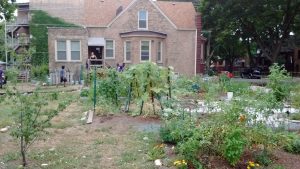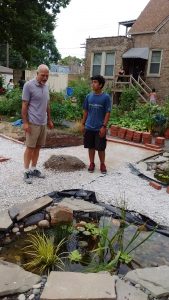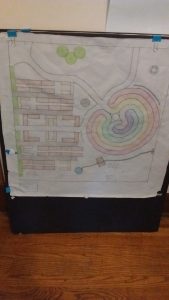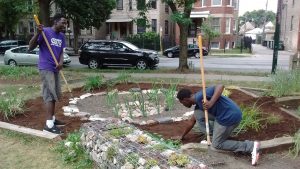Faith and Health Leadership: Best Practices
Kimball Avenue Church, Chicago
When faced with a facility crisis, Kimball Avenue cleared new ground and ended up growing healthy community.
If you visit the Kimball Avenue Church in Chicago, you may sing together, eat together, or get your hands dirty…but you won’t do it inside a building.
In 2010, the congregation of Kimball Avenue Church worshipped in a historic building at the corner of Kimball and Medill…until a steam boiler pipe burst and damaged the building beyond affordable repair. So, in 2011, the congregation boldly moved forward in disassembling the building and opening up the space for God to fill it in.

Standing where Kimball Avenue Sanctuary used to be, looking at the parish house, you can see the fruits of their labor
A community group named Corner Farm Chicago was first to ask about the open space to expand their garden program, which has grown like a mustard seed. Three years later, Corner Farm is no longer involved, but the garden now functions as an educational playground, an outdoor concert venue, a food producer, a ‘Little Free Library’, a place for spiritual contemplation, an architectural testing ground, a host site for Tai Chi, and a place where the community is welcome to stroll among the wild plum trees.
“We really see it as a part of our community outreach,” says Pastor Bruce Ray. “We have [at Kimball Avenue Church] maybe 3 families who have garden plots, and the rest of them are for the community. “We’re trying to do more than just grow food. We really want to grow relationships, use it to connect people who normally wouldn’t be connected.”
The initial gardening partnership served 17 families, but they didn’t necessarily reflect the full range of families
in the community. “Gardening in this community has tended to be among millennial whites. We wanted to make it a little more colorful, and that is a challenge…it’s hard to bridge certain demographics.” But Pastor Ray is excited about the way it has evolved.
Today the garden plots are divided between St. Luke’s Lutheran Church’s community dinner program, Nuestra Señora De Las Americas Episcopal Church, 18 families, and …students!
“We have had over 75 high school students through Design! Build! Grow! Eat! (an After School Matters program) that have been helping us design our gardens,’ says Ray (see picture above). “Now, over 30 of those kids have been participating in our gardens…and 95% of them are youth of color. So it’s kind of fun that they are part of the growing community and not just the outside helpers.”
The focus on health has infused other ministries and partnerships of Kimball Avenue’s congregation as well. In 2009, the Center for Faith and Community Health Transformation began conversations around childhood obesity in Logan Square, focused on what faith communities could do with policies, systems and environmental change to alter the rising trend of obesity, both within their congregations and for the wider community. Kimball Avenue is a shining example of some of those policies:
Ray explains, “for our [prepared] monthly meal in collaboration with First Lutheran Church, we have a very strict policy that we have to have protein, not a lot of carbs, concentrate on higher fiber, always have salad, always have fruit, and we limit the sweets. We try to do creative things, things that are appealing visually, things that are healthy for you…we try to stay away from spaghetti each week.”
In addition, the garden program doesn’t stop with growing – the coordinator Dawn Marie Galtieri made sure it included cooking. After School Matters has used the kitchen of the parsonage to teach about cooking with produce from the garden, analyzing the taste and uses of domesticated and wild plants. The program has even had a guest visit from celebrity chef Matthew Kerney from Michelin rated “Longman & Eagle!”

Pastor Bruce Ray talks with Isaiah Fernandez, 17, a leader in the Kimball Avenue Garden, in front of their frog pond
“I’ve really learned a lot. There are foods I’ve never tasted that now I can cook. But the gardening is my favorite part,” says Isaiah Fernandez, age 17.
This year, the space has added ponds and a waterfall, a stone wall for moss, walkways with fruit trees, a Saturday morning Tai Chi class, and they are looking forward to the creation of a meditation and prayer labyrinth. Ray and the congregation see all of it as a service to the community.
“We initially thought about putting up a fence, but eventually decided against it. We watch when families with young kids come by – not necessarily to take produce, although some of that happens – but we watch the parents and kids walk up and down the rows. There’s evidence of the benefits of green space that increases a sense of well-being…and we’re glad we didn’t put up a fence because we want people to know they are welcome to find refreshment here. Just the other day two people stopped in to tell me how thankful they are for the green space here… they don’t garden but just love having the green space available for the community.”
Ray says the footprint of the old building has become more than just a mission of the church. “It’s a way of connecting them to us and us to them. I really think we need to rethink how church is done, and get it outside of a building more and more.”





